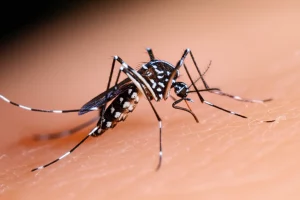Dengue Diagnosis Gets a High-Tech Upgrade: AI, Fog, and a Two-Level Approach
Hey there! Let’s chat about something super important: healthcare, specifically how we can get better at spotting diseases like dengue. You know, those pesky mosquito-borne illnesses that are, frankly, a growing headache worldwide? They’ve become a massive deal over the last fifty years, largely thanks to things like more people living closer together in cities and, well, just how connected our world is now.
Dengue is right up there as one of the most significant ones. It’s spread mainly by those Aedes mosquitoes, and when it hits, it can really knock people off their feet. The symptoms can be tricky – high fever, nasty headaches, rashes, vomiting, you name it. The problem is, diagnosing it isn’t always straightforward, especially when there’s a big outbreak and healthcare pros are swamped.
Traditionally, diagnosis often relies on doctors’ experience, which is great, but when you have *tons* of cases, even the best can get overwhelmed, and mistakes can happen. Plus, we need ways to keep tabs on things remotely and handle massive amounts of patient data. Cloud computing is awesome for storage and remote access, but honestly, the delay (latency) can be a real buzzkill when you need answers *fast*.
Why We Need Smarter Dengue Diagnosis
So, yeah, dengue is a global challenge. The World Health Organization (WHO) even put it second only to COVID-19 in terms of impact back in 2020. Countries like the Philippines, Vietnam, India, Colombia, and Brazil see huge numbers. A big part of the spread is linked to rapid urbanization and infrastructure that just can’t keep up with mosquito control. The main culprits? Aedes aegypti and Aedes albopictus mosquitoes.
Diagnosis usually involves looking at symptoms (like fever, rash, headache) to identify *probable* cases, and then doing lab tests to confirm. We’re talking about serological tests like NS1 (an antigen test, useful early on) and IgG/IgM (antibody tests, usually later). But even with tests, there are challenges. Early detection is key because there’s no specific treatment, only managing the symptoms. Lack of awareness, limited facilities, and even shortages of test kits (like RT-PCR) make things harder in some places.
This is where technology, specifically machine learning and deep learning, comes into play. They can really help doctors make quicker, more informed decisions. But we still have that latency issue with traditional cloud setups when speed is critical, like during an outbreak.
Enter Fog Computing: Speeding Things Up
Okay, so imagine the cloud is a big data center far away. Fog computing is like having mini-data centers, or ‘fog nodes,’ much closer to where the action is happening – right there at the ‘edge’ of the network, near the clinics or even wearable sensors. This setup drastically cuts down on latency. It means we can process data and get diagnostic information out *way* faster than sending it all the way to the distant cloud and back. This is crucial for sending out emergency alerts and getting speedy diagnoses.
Integrating fog computing into healthcare gives us some neat advantages:
- Real-time notifications
- Efficient use of resources
- Faster access to medical info
- Better quality of service, especially for time-sensitive tasks.
Because early diagnosis and treatment are so vital for controlling dengue, using the fog layer as an intermediary just makes sense. It handles the immediate stuff, while the cloud can still be used for long-term storage and bigger analyses later on.
The Two-Level Tango: How it Works
Now, here’s the really cool part of this study: they didn’t stop at just one step. They proposed a dual-level diagnosis framework. Think of it like how a doctor actually works:
- First, they look at your symptoms and medical history to see if dengue is likely (Level 1: Probable cases).
- Then, if it seems probable, they order specific lab tests to confirm it (Level 2: Confirmed cases).
Most previous studies only focused on that first step, identifying probable cases based on symptoms. But starting treatment based *only* on symptoms can lead to incorrect diagnoses and treatments. This dual-level approach, mimicking the real-world process, aims to minimize those errors and potentially save lives by confirming the disease.
![]()
Level 1: Symptoms and a Clever AI Model
Level 1 happens in the fog layer. Patient symptoms are sent from the ‘edge’ (where the patient is) to the fog node. Why the fog? To handle the processing and storage closer to the source, avoiding cloud latency. The tech doing the heavy lifting here is a machine learning model called a Multilayer Perceptron (MLP). But not just any MLP – this one is specifically optimized and normalized lightweight MLP (ONL-MLP). Lightweight is key because fog nodes might not have the same beefy processing power as a massive cloud data center.
Before the model gets to work, the data goes through some important steps:
- Preprocessing: Cleaning up the data, handling any missing bits (like using the average value if a symptom is missing).
- Feature Reduction: Getting rid of symptoms or data points that don’t really help predict dengue. They used something called the Pearson Correlation coefficient to see how strongly each symptom relates to a confirmed dengue case. If a symptom didn’t correlate much, or even correlated negatively (like a cough or sore throat, which are less typical for dengue), they removed it. This makes the model faster and more efficient.
The lightweight MLP model itself is designed with fewer layers and parameters than typical deep learning models, making it suitable for the resource-constrained fog environment. They used techniques like Batch Normalization (to stabilize training) and Dropout (to prevent the model from ‘memorizing’ the training data too well, which is called overfitting, especially important with smaller datasets). They also used techniques like K-fold cross-validation (to make sure the model works well on data it hasn’t seen before) and Grid Search optimization (to find the best settings for the model).
The result? This lightweight MLP model achieved an impressive 92% accuracy in identifying probable dengue cases based on symptoms, even with a relatively small dataset. It also hit 100% precision (meaning when it said someone *probably* had dengue, it was never wrong in the test set!) and a 90% F1 score. The list of these probable cases is then sent back down to the edge layer.
Making Sense of the AI: Explainability (XAI)
Now, MLPs, like many powerful AI models, can sometimes feel like a “black box.” You give them data, they give you a prediction, but it’s hard to see *why* they made that specific prediction. In healthcare, knowing the ‘why’ is critical! You need to trust the diagnosis and understand what factors led to it. This is where Explainable Artificial Intelligence (XAI) comes in.
This study incorporated XAI tools, specifically SHAP (SHapley Additive exPlanations) and LIME (Local Interpretable Model-agnostic Explanations), to shed light on the MLP’s decisions. These tools help break down how each symptom or feature contributed to the model’s prediction for a specific patient or overall. SHAP, for example, can show you which symptoms pushed the prediction towards ‘dengue probable’ and which pushed it away, and by how much. LIME provides similar local explanations.
Using XAI provides several benefits:
- Increased Transparency: You can see *why* the AI thinks someone might have dengue.
- Builds Trust: Healthcare professionals and patients are more likely to trust the AI if its reasoning is clear.
- Regulatory Compliance: Many regulations require AI decisions, especially in critical fields like medicine, to be explainable.
- Actionable Insights: Understanding which symptoms are most influential helps doctors focus their attention.
- Promotes Collaboration: It helps bridge the gap between the AI’s output and the doctor’s clinical knowledge.
By using tools like SHAP and LIME, this framework doesn’t just give a prediction; it gives a reason, which is super valuable in a medical context.

Level 2: Confirming with Tests
Remember that list of *probable* cases sent back to the edge layer? This is where Level 2 kicks in. At the edge (think the local clinic or hospital), the healthcare professional takes the serological test results (NS1, IgG, IgM) for these probable cases. This is the crucial step to move from ‘probable’ to ‘confirmed’.
Level 2 uses a simpler method: rule-based inference. Based on a separate dataset of confirmed cases and their test results, simple rules were generated. For example, a rule might look something like: “IF NS1 is positive (1) AND IgG is positive (1), THEN Outcome is Confirmed Dengue (1).” Or “IF NS1 is negative (0) AND IgG is negative (0) AND IgM is negative (0), THEN Outcome is Not Dengue (0).”
This rule-based approach is lightweight and fast, perfect for processing at the edge layer. It takes the uncertainty out of the probable cases by using the definitive lab results. Once cases are confirmed (or ruled out), this permanent information is sent up to the cloud for long-term storage and future analysis.
Why This Approach Rocks (and What’s Next)
So, putting it all together, this dual-level framework using lightweight AI in the fog, explained by XAI, and confirmed by rule-based inference at the edge, offers some significant advantages:
- Speed: Fog computing reduces latency for faster initial diagnosis and alerts.
- Accuracy e Confirmation: The dual-level approach, especially Level 2 confirmation with lab tests, reduces the risk of misdiagnosis compared to symptom-only methods.
- Explainability: XAI makes the AI’s predictions understandable, building trust and providing actionable insights for healthcare professionals.
- Efficiency: The lightweight MLP is suitable for the resource constraints of fog environments.
- Real-World Mimicry: It follows a diagnostic path similar to what doctors actually do.
- Human-in-the-Loop: Healthcare professionals are involved, validating results and providing the Level 2 input.
The study showed great results (92% accuracy, 100% precision for Level 1) and demonstrated that the model wasn’t overfitting, even on a smaller dataset (ROC AUC of 0.97 for both training and testing – pretty solid!).
Of course, like any research, there are limitations and exciting future possibilities. The dataset used was relatively small, and training on larger, more diverse data would likely improve the model further. Testing this framework in a real-world fog computing testbed is the next logical step to check its scalability and effectiveness in practice. While the current setup involves healthcare professionals for Level 2 input, making the entire process more automated is a future goal.
Scaling this kind of system to different regions or diseases also brings challenges – varying healthcare infrastructure, data availability issues (some places still use paper records!), and regulatory hurdles like HIPAA and GDPR for data privacy. Techniques like federated learning (training models across different locations without sharing sensitive raw data) could help with privacy and cross-border deployment. Adapting the AI models for different diseases requires specific tuning and potentially different data types (like images for skin rashes or other visual symptoms).
Future work could also explore incorporating more data sources (like environmental data or wearable sensor info), using more advanced AI models that track disease progression over time (like RNNs or Transformers), or even hybrid models that combine the current approach with, say, a CNN to analyze images of rashes. And for robust security and data sharing, integrating blockchain technology is a cool idea mentioned.
Overall, this study presents a really promising step towards making dengue diagnosis faster, more accurate, more reliable, and understandable, leveraging the power of AI and fog computing right where it’s needed most – closer to the patient.

Source: Springer







